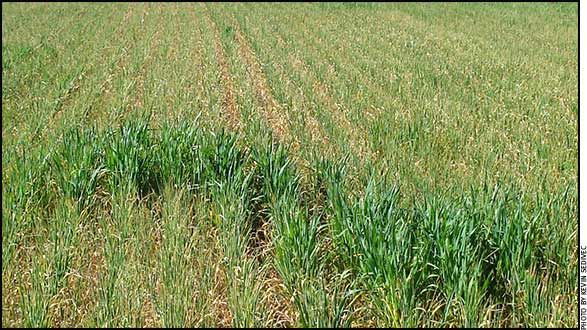HEALTH & NUTRITION...

Check Nitrate Levels in Forages
Test hay for nitrate levels before it’s fed to cattle.
Nitrate in forages can sometimes be a problem for cattle, according to Kevin Sedivec, professor of range science at North Dakota State University. Depending on growing conditions, nitrate levels may be excessive, and those levels remain high in stored feeds.
“Nitrate toxicity potential can occur in two scenarios. The first is annual forage crops harvested for hay. Nitrate levels can be excessive if the grower uses too much nitrogen fertilizer. If you fertilize the crop thinking in terms of what would be adequate for “X” amount of production and it’s a dry summer — and the crop has less biomass than expected — there will be elevated nitrogen levels,” he explains.
“I recommend testing soils for nitrogen and then add fertilizer as needed to achieve the production potential,” he says. Read more.
The Matching Game
Technology, economics and consumers dictate cattle feeding.
Cattle have changed. If your management hasn’t, animal scientist Robbi Pritchard suggests you take a look to be sure it’s still relevant.
The South Dakota State University professor addressed cattle feeders and allied industry at the Feeding Quality Forum in August.
“Genetics are better, and our growth-enhancement tools are better, and we know a lot more about them,” Pritchard said, noting the term “precision ag” is typically reserved for row-crop discussions. It doesn’t have to be. Read more.
Ergot Problems
Learn the signs of ergot and make management changes
before it is too late.
Ergot is a fungus that grows on certain grasses and grain plants when moisture conditions are just right. Ergot becomes a problem mainly after a wet season, rarely during dry conditions. The fungus replaces the seedhead with a dark brown/black mass and produces toxic alkaloids. One or more of the kernels in the seedhead are replaced with this dark, hard “ergot body.”
Various types of alkaloids in ergot affect cattle in different ways. Effects on the nervous system result in muscle spasms in the hind legs, incoordination, loss of balance and sometimes, temporary paralysis. More commonly, the toxic alkaloids impair blood circulation to the extremities due to constricting of blood vessels, which can result in loss of ears, tail or feet.
Mild cases of ergot poisoning may show up as poor production (lower weight gain, drop in milk production, inability to handle hot or cold weather, reproductive problems, or abortion). Often the signs of ergot poisoning are similar to those of fescue toxicosis. Read more.

Rick Rasby
Ridin’ Herd
Plan to reduce feed costs
Profitable cow-calf producers tend to have three important items in line with one another: weaning weight in line with reproductive rate in line with cost of producing a weaned calf.
Weaning weight and reproductive rate will likely not be maximum, but rather optimum given the feed, labor and capital resources available. In addition, maximizing the use of winter and summer grazing opportunities and using harvested and commercial feeds at the “proper” time are important in making the cow-calf enterprise profitable. Read more.
Black Vultures on the Rise,
Growing Problem for Livestock Producers
Black vultures have been known to target newborn calves.
Livestock producers beware — black vultures are on the hunt, and they aren’t just looking for dead animals. These migratory birds are known to attack and eat live animals, too.
The birds have become a problem for many Ohio livestock producers in recent years, said Stan Smith, an Ohio State University (OSU) Extension program assistant in agriculture and natural resources. Black vultures have been a growing problem for Ohio livestock producers during the past 15 years. Read more.
Controlling Lice in Cattle: Now is the Time
Treatment in the fall can help mitigate lice infestations throughout the year.
If producers notice their cattle rubbing, biting or scratching with irritation at their neck, shoulders and rump — including the loss of hair in those areas — they could be experiencing a lice problem. Lice are a common annoyance to cattle, especially in the winter months. The energy sucking lice rob from the animal can result in anemia, slowed recovery from diseases and decreased gain during infestation.1
“Cattle producers and their herds experience more lice problems during the wintertime, by far,” said Jon Seeger, managing veterinarian with Zoetis. “Now is the time to treat cattnle for lice.” Read more.
Controlling Lice
Tips for choosing the right delousing products for the cow herd.
Greg Johnson, veterinary entomologist, Montana State University, says there are three species of sucking lice in most cattle-producing states and one species of biting/chewing louse.
“Many producers treat cattle in the fall; the animals either get injected or poured with one of the avermectins, including ivermectin or generics: moxidectin, doramectin or eprinomectin. Because these products are systemic, they control most internal and external parasites. The injectable avermectins will control the blood-sucking lice but not the biting louse,” says Johnson. Read more.
Cattle Diseases: Common Conditions/Terms
Click here for a list of common conditions and terms related to beef cattle diseases, such as anaplasmosis, brucellosis, BVD, E. coli, IBR and others.
[Click here to go to the top of the page.]






